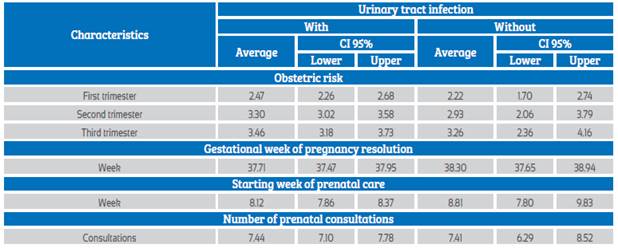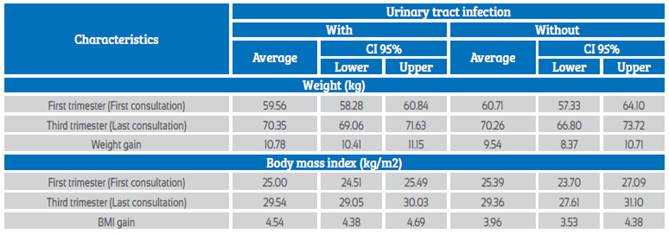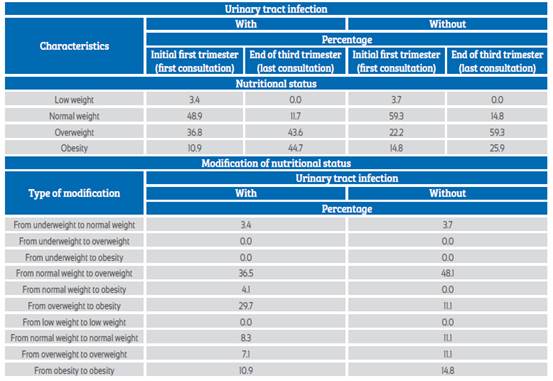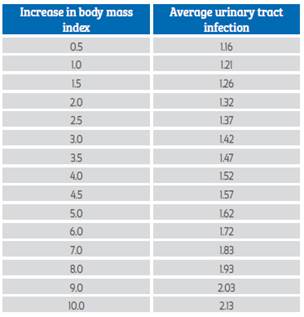Services on Demand
Journal
Article
Indicators
-
 Cited by SciELO
Cited by SciELO
Related links
-
 Similars in
SciELO
Similars in
SciELO
Share
Revista Peruana de Ginecología y Obstetricia
On-line version ISSN 2304-5132
Rev. peru. ginecol. obstet. vol.69 no.1 Lima Jan./Mar. 2023 Epub Mar 27, 2023
http://dx.doi.org/10.31403/rpgo.v69i2475
Original paper
Association of body mass index increase and the presence of urinary tract infection in primigravidae
1. Instituto Mexicano del Seguro Social, Oaxaca, Mexico.
Introduction:
The nutritional status of women before and during pregnancy is one of the determinants of the risk of maternal morbidity and mortality.
Objective:
To determine the relationship between the increase in body mass index and the presence of urinary tract infection in primigravidae.
Methods:
Case-control study in primigravidae records. We studied sociodemographic variables (age, schooling, life as a couple and occupation), obstetric conditions (obstetric risk, weeks of beginning of prenatal control, weeks of pregnancy resolution and number of prenatal visits), anthropometry at the beginning and end of pregnancy (weight, height, body mass index and nutritional condition -underweight, normal weight, overweight and obesity-, weight gain and body mass index gain), and modification of nutritional condition at the beginning and end of pregnancy. Statistical analysis was performed with percentages, averages, confidence intervals for averages, Chi2 test, odds ratio, confidence intervals for odds ratio, simple linear regression, and projection of event occurrence.
Results:
When the increase in body mass index was 5 kg/m2, the mean urinary tract infection corresponded to 1.62 and, if the increase in body mass index was 10 kg/m2, the mean urinary tract infection was 2.3.
Conclusion:
In our study, the greater the increase in body mass index during pregnancy of the primigravida, the greater her probability of presenting urinary tract infection.
Key words: Pregnancy complications; infectious; Urinary tract infections; Body mass index
Introduction
The physiological, psychological and physical changes characteristic of the first pregnancy are determined to a large extent, in addition to maternal age, by the physical and nutritional status prior to pregnancy1-5. In particular, nutritional status prior to and during pregnancy has been associated with increased maternal morbidity and mortality, which is not a minor issue given the characteristics of the population. In this regard, it has been published that the prevalence of overweight and obesity in women in the reproductive stage is 42.5%, a condition that becomes critical when identifying that approximately half of the pregnant women who are overweight at the beginning of pregnancy increase their weight by more than the accepted values. The implication is reflected in the immune response secondary to the chronic inflammatory process typical of obesity, as well as the activation of the proinflammatory cytokine cascade (TNF-α, IL-1β, IL-6, IL-12 and IFN-γ), with repercussions in the immune response and its relationship with the presence of infection2,6-8.
Maternal obesity has been identified as a risk factor for urinary tract infection during pregnancy3,4,6,8. In this scenario, urinary pH decreases, urinary oxalate increases, as well as uric acid, sodium and phosphate excretion. In addition, the hormonal state of pregnancy itself favors urinary tract infection9-11.
The objective of the present investigation was to determine the relationship between the increase in body mass index and the presence of urinary tract infection in primigravidae.
Methods
A case-control design was performed with records of primigravidae attended in a social security institution in the city of Oaxaca, Mexico, in the period from January 2019 to December 2020.
Cases were identified as primigravidae who presented one or more urinary tract infections during pregnancy, and controls were identified as primigravidae who did not present urinary tract infections during pregnancy. Diagnosis was made by general urine examination (pH greater than 6, density greater than 1,020, leukocyturia greater than 8 leukocytes/mL and bacteriuria greater than 100,000 colony-forming units (CFU)/mL), with urinary signs and symptoms (urgency, frequency, dysuria, pyuria and hematuria), as well as urine culture (100,000 or more CFU per mL).
We excluded files of primigravidae with a diagnosis of threatened abortion, preterm delivery, gestational diabetes or gestational hypertension during prenatal control. Files with incomplete information and those with a history of urinary tract infection or cervicovaginitis prior to pregnancy were eliminated.
The sample size was calculated with the case-control formula with confidence level for a 95% rejection zone (Zα=1.64), power of the test of 80% (Zβ=0.84), assuming that in the group with urinary tract infection 60% had an increase of more than 5 kg/m2 body mass index (p 0=0.60) and in the group without urinary tract infection 25% had an increase of more than 5 kg/m2 body mass index (p 1=0.25). The calculated size corresponded to 28 primigravidae; however, we worked with 266 cases and 27 controls.
The sampling technique was non-random by consecutive cases, using as a sampling frame the list of files of primigravidae attended during the study period.
We studied sociodemographic variables (age, schooling, life as a couple and occupation), obstetric conditions (obstetric risk, weeks of prenatal control, weeks of pregnancy resolution and number of prenatal visits), anthropometry at the beginning and end of pregnancy (weight, height, body mass index and nutritional condition -underweight, normal weight, overweight and obesity-, weight gain and body mass index gain) and modification of nutritional condition at the beginning and end of pregnancy.
The statistical analysis plan included percentages, averages, confidence intervals for averages, Chi2 test, odds ratio, confidence intervals for odds ratio, simple linear regression and projection of event occurrence.
Results
In the group with urinary tract infection, the mean age was 27.9 years (95% CI: 27.2-28.6) and in the group without urinary tract infection the age was 28.6 years (95% CI: 26.3-30.9). Table 1 shows the sociodemographic characteristics for each of the groups.
In the groups with and without urinary tract infection, the obstetric risk was low in all trimesters of gestation, as revealed by the score of less than 3 points. Table 2 shows the obstetric and gynecological characteristics by group.
Table 2 Obstetrical and gynecological history of primigravidae with and without urinary tract infection.

In the group with urinary tract infection the height was 1.54 meters (95% CI: 1.53-1.55) and in the group without urinary tract infection it was 1.55 meters (95% CI: 1.52-1.57). The body mass index in the first trimester in the UTI group was 25.00 kg/m2 (95% CI: 24.51-25.49) and in the non-UTI group it was 25.39 kg/m2 (95% CI: 23.70-27.09). Table 3 shows the pattern of body mass index and weight in the first and third trimester of gestation.
Table 3 Behavior of body weight and body mass index of primigravidae with and without urinary tract infection.

In the group with urinary tract infection at the beginning of pregnancy, 48.9% of the primigravidae were in a normal nutritional status and at the end of pregnancy the percentage changed to 11.7%; in the group without urinary tract infection the values were 59.3% and 14.8%, respectively. In the group with urinary tract infection, 36.5% of the primigravidae went from normal weight to overweight, and in the group without urinary tract infection the percentage was 48.1%. Table 4 presents this information.
The average number of urinary tract infections during pregnancy was 1.57 (95% CI: 1.45 to 1.68) and during pregnancy 90.8% of primigravidae (95% CI: 87.5 to 94.1) had 1 or more urinary tract infections.
The regression equation to predict the number of urinary tract infection from the increase in body mass index was:
y = 1.111 + 0.102 (increase in body mass index).
When the increase in body mass index was 5 kg/m2, the average number of urinary tract infection corresponded to 1.62 and, if the increase in body mass index was 10 kg/m2, the average number of urinary tract infection was 2.3. Table 5 shows the relationship between the increase in body mass index and the average urinary tract infection.
Discussion
Currently, public health challenges are diverse. Chronic degenerative problems are the cause of special attention due to their permanence and associated complications in the long term. Among them, obesity has been considered an epidemic that is difficult to control and has implications for the future health of the population. In particular, obesity in pregnancy has been related to maternal morbidity and mortality; specifically, urinary tract infection has been identified as a frequent reason for attention. There are publications on this subject. The subject of the article presented refers to the pregnant primigravida and the important relationship between weight gain and urinary tract infection12-14.
The indicators to evaluate the nutritional status of pregnant women are diverse. There is no consensus on this matter. However, the body mass index seems to offer advantages that allow comparison. For this reason, and assuming the weaknesses it may have, in this research it was the indicator used to carry out the evaluation.
The literature identifies a high prevalence of obesity and overweight in the population. The sample studied reveals the importance of obesity as a health problem from two perspectives, first, because it is a young population in which a better health condition would be expected and, second, because it is a pregnant population in which pregnancy would be expected to be conceived as a planned act, for which the woman prepares herself from the psychological and physical point of view, among others6,7,15.
The lack of statistical difference in weight and body mass index in the first trimester between pregnant women with and without urinary tract infection ensures the similarity of the groups studied and allows comparison of the change in body mass index with the presence of urinary tract infection.
It is true that in the group without urinary tract infection the prevalence of overweight was higher than in the group with infection. However, it should be clear that the expected weight gain during normal pregnancy is close to 10 kilograms, a condition that will place the woman at the end of pregnancy in the overweight category, not because of the increase in fat cells, but because of the weight of the product and the elements formed around it. This could suggest that classifying a pregnant woman as overweight at the end of pregnancy corresponds to a normal state3-5.
Contrary to the above, in the group with urinary tract infection, the prevalence of obesity at the end of pregnancy was higher than in the group without infection. In this regard, it can be pointed out that the inflammatory changes inherent to obesity during pregnancy produce functional and structural changes in the urinary tract that favor infection by increasing the storage of postvoid residues and hormonal degradation products that increase urinary pH. This fact highlights what very few articles comment on the increase in weight/body mass index and the association with urinary tract infection10,11.
The literature on the average number of urinary tract infections during pregnancy is consistent with the results of this article, but it demonstrates the association between increase in weight/body mass index and urinary tract infection. In this regard, the physical changes inherent to pregnancy and those inherent to the increase in body fat have already been pointed out as risk factors10,11,14.
In conclusion, the greater the increase in body mass index during pregnancy of the primigravida, the greater the probability of presenting urinary tract infection. Given this statement, it is important to prepare for pregnancy by reducing body weight with nutritional interventions and physical activity, as well as preventive actions during prenatal care to reduce the frequency of urinary tract infection.
REFERENCES
1. Barrera H, Germain A. Obesidad y embarazo. Rev Med Clin Condes. 2020;23(2):154-8. [ Links ]
2. Menéndez Guerrero M, Navas Cabrera M, Hidalgo Rodríguez S, Castellanos M. El embarazo y sus complicaciones en la madre adolescente. Rev Cubana Obstet Ginecol. 2017;(3):1-15. [ Links ]
3. Secretaria de Salud. Control Prenatal Con Enfoque De Riesgo. México: CENETEC; 2009. pp. 32-35. [ Links ]
4. Secretaria de Salud. Control Prenatal con Atención Centrada en la Paciente. México: CENETEC; 2017. pp. 54-55. [ Links ]
5. Ferrer Arreola L, Alvarado de Luzuriaga E, Valenzuela Soto B. Guía para la Atención Prenatal en Medicina Familiar. México: Instituto Mexicano del Seguro Social; 2016. [ Links ]
6. Syed H, Slayman T, Thoma KD. Physical activity and exercise during pregnancy and the postpartum period. ACOG. 2021;137(2):375-6. doi: 10.1097/AOG.0000000000004266 [ Links ]
7. Blancas Flores G, Almanza Pérez JC, López Roa RI. La obesidad como un proceso inflamatorio. Nutr Hosp. 2015;31(6):2352-8. [ Links ]
8. Rodríguez Valencia MA. Complicaciones del Embarazo en Adolescente Primigesta en el Hospital de la Mujer Aguascalientes. Aguascalientes: Hospital de la Mujer; 2015. [ Links ]
9. Carrillo Mora P, García Franco A, Soto Larad M, Rodríguez Vásquez G, Pérez Villalobos J, Martínez Torres D. Cambios fisiológicos durante el embarazo normal. Rev Fac Med (Méx). 2021;64(1):1-10. https://doi.org/10.22201/fm.24484865e.2021.64.1.07 [ Links ]
10. Bogantes Rojas J, Solano Donato G. Infecciones Urinarias en el Embarazo. Rev Med de Costa Rica y Centroamérica. 2016;68(593):233-6. [ Links ]
11. Secretaria de Salud. Prevención, Diagnóstico y Tratamiento de la Infección del Tracto Urinario Bajo Durante el Embarazo, en el Primer Nivel de Atención. México: CENETEC; 2016. pp. 12-17. [ Links ]
12. González Moreno J, Juárez López JS, Rodríguez Sánchez JL. Obesidad y embarazo. Revista Médica MD. 2018;4(4):270-5. [ Links ]
13. Pradenas AM. Infecciones Cérvico Vaginales y Embarazo. Rev Med Clin Condes. 2016;25(6):925-35. [ Links ]
14. Aranda J, de la Revilla L, de Luna J. Riesgo obstétrico: evaluación de índices y criterios existentes. ELSEVIER. 2016;(4):1-2. [ Links ]
15. Ovalle A, Martínez M.A, Fuentes A, Marques X. Obesidad, factor de riesgo de infección bacteriana ascendente durante el embarazo. Rev Med Chile. 2016;144:476-82. [ Links ]
Ethical considerations: The protocol was registered and authorized by the local ethics and research committee of the health institution where it was performed.
Patient consent: Since we worked with files, the authorization to collect the information was made with the authorities of the institution, which is in writing.
Cite as: Tornel Miguel K, Villegas Martínez D, Solano Ceh A, Villarreal Ríos E, Galicia Rodríguez L, Elizarrarás Rivas J. Association of body mass index increase and the presence of urinary tract infection in primigravidae. Rev peru ginecol obstet. 2023;69(1). DOI: https://doi.org/10.31403/rpgo.v69i2475
Received: January 24, 2023; Accepted: February 28, 2023











 text in
text in 






